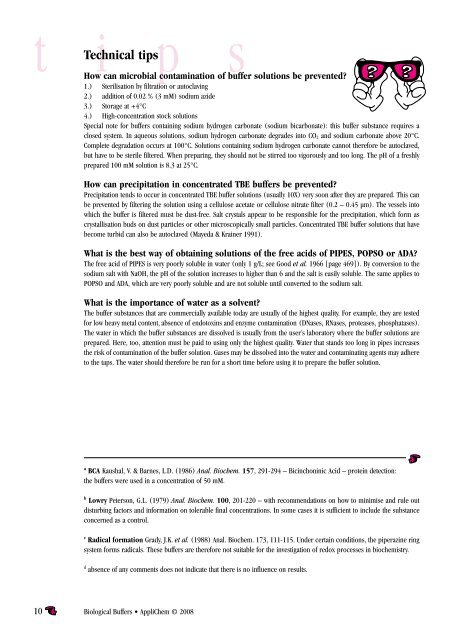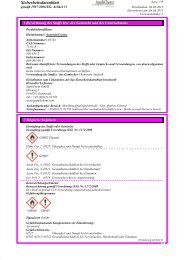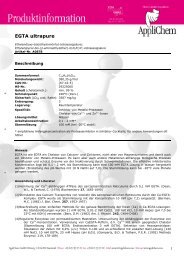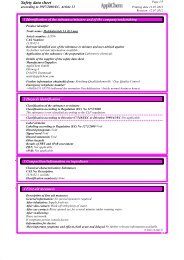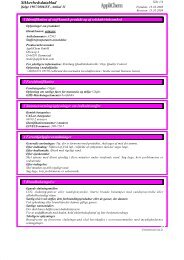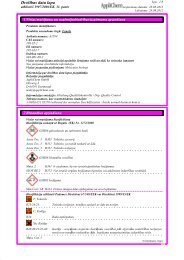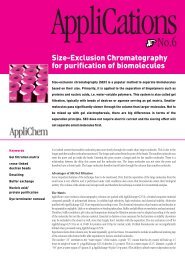Biological Buffers • AppliChem
Biological Buffers • AppliChem
Biological Buffers • AppliChem
You also want an ePaper? Increase the reach of your titles
YUMPU automatically turns print PDFs into web optimized ePapers that Google loves.
t i p s<br />
Technical tips<br />
How can microbial contamination of buffer solutions be prevented?<br />
1.) Sterilisation by filtration or autoclaving<br />
2.) addition of 0.02 % (3 mM) sodium azide<br />
3.) Storage at +4°C<br />
4.) High-concentration stock solutions<br />
Special note for buffers containing sodium hydrogen carbonate (sodium bicarbonate): this buffer substance requires a<br />
closed system. In aqueous solutions, sodium hydrogen carbonate degrades into CO2 and sodium carbonate above 20°C.<br />
Complete degradation occurs at 100°C. Solutions containing sodium hydrogen carbonate cannot therefore be autoclaved,<br />
but have to be sterile filtered. When preparing, they should not be stirred too vigorously and too long. The pH of a freshly<br />
prepared 100 mM solution is 8.3 at 25°C.<br />
How can precipitation in concentrated TBE buffers be prevented?<br />
Precipitation tends to occur in concentrated TBE buffer solutions (usually 10X) very soon after they are prepared. This can<br />
be prevented by filtering the solution using a cellulose acetate or cellulose nitrate filter (0.2 – 0.45 µm). The vessels into<br />
which the buffer is filtered must be dust-free. Salt crystals appear to be responsible for the precipitation, which form as<br />
crystallisation buds on dust particles or other microscopically small particles. Concentrated TBE buffer solutions that have<br />
become turbid can also be autoclaved (Mayeda & Krainer 1991).<br />
What is the best way of obtaining solutions of the free acids of PIPES, POPSO or ADA?<br />
The free acid of PIPES is very poorly soluble in water (only 1 g/L; see Good et al. 1966 [page 469]). By conversion to the<br />
sodium salt with NaOH, the pH of the solution increases to higher than 6 and the salt is easily soluble. The same applies to<br />
POPSO and ADA, which are very poorly soluble and are not soluble until converted to the sodium salt.<br />
What is the importance of water as a solvent?<br />
The buffer substances that are commercially available today are usually of the highest quality. For example, they are tested<br />
for low heavy metal content, absence of endotoxins and enzyme contamination (DNases, RNases, proteases, phosphatases).<br />
The water in which the buffer substances are dissolved is usually from the user’s laboratory where the buffer solutions are<br />
prepared. Here, too, attention must be paid to using only the highest quality. Water that stands too long in pipes increases<br />
the risk of contamination of the buffer solution. Gases may be dissolved into the water and contaminating agents may ad here<br />
to the taps. The water should therefore be run for a short time before using it to prepare the buffer solution.<br />
a BCA Kaushal, V. & Barnes, L.D. (1986) Anal. Biochem. 157, 291-294 – Bicinchoninic Acid – protein detection:<br />
the buffers were used in a concentration of 50 mM.<br />
b Lowry Peterson, G.L. (1979) Anal. Biochem. 100, 201-220 – with recommendations on how to minimise and rule out<br />
disturbing factors and information on tolerable final concentrations. In some cases it is sufficient to include the substance<br />
concerned as a control.<br />
c Radical formation Grady, J.K. et al. (1988) Anal. Biochem. 173, 111-115. Under certain conditions, the piperazine ring<br />
system forms radicals. These buffers are therefore not suitable for the investigation of redox processes in biochemistry.<br />
d absence of any comments does not indicate that there is no influence on results.<br />
10 <strong>Biological</strong> <strong>Buffers</strong> <strong>•</strong> <strong>AppliChem</strong> © 2008


